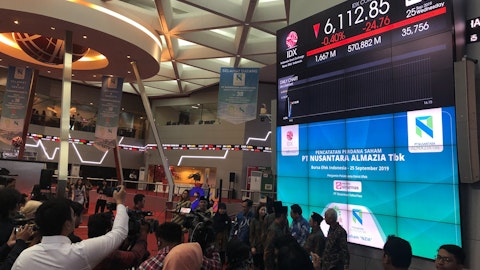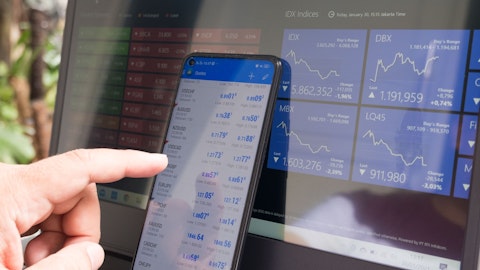TransDigm Group Incorporated (NYSE:TDG) Q1 2024 Earnings Call Transcript February 8, 2024
TransDigm Group Incorporated beats earnings expectations. Reported EPS is $7.16, expectations were $6.37. TransDigm Group Incorporated isn’t one of the 30 most popular stocks among hedge funds at the end of the third quarter (see the details here).
Operator: Good day and thank you for standing by. Welcome to the TransDigm Group Incorporated First Quarter 2024 Earnings Conference Call. At this time, all participants are in a listen-only mode. After the speakers’ presentation, there will be a question-and-answer session. [Operator Instructions] Please be advised, that today’s conference is being recorded. I would now like to hand the conference over to your speaker today, Jaimie Stemen, Director of Investor Relations. Please go ahead.
Jaimie Stemen: Thank you and welcome to TransDigm’s fiscal 2024 first quarter earnings conference call. Presenting on the call this morning are TransDigm’s President and Chief Executive Officer, Kevin Stein; Co-Chief Operating Officer, Joel Reiss; and Chief Financial Officer, Sarah Wynne. Also present for the call today is our Co-Chief Operating Officer, Mike Lisman. Please visit our website at transdigm.com to obtain a supplemental slide deck and call replay information. Before we begin, the company would like to remind you that statements made during this call, which are not historical in fact, are forward-looking statements. For further information about important factors that could cause actual results to differ materially from those expressed or implied in the forward-looking statements, please refer to the company’s latest filings with the SEC available through the Investors section of our website or at sec.gov.
The company would also like to advise you that during the course of the call, we will be referring to EBITDA, specifically EBITDA as defined, adjusted net income and adjusted earnings per share, all of which are non-GAAP financial measures. Please see the tables and related footnotes in the earnings release for a presentation of the most directly comparable GAAP measures and applicable reconciliations. I will now turn the call over to Kevin.
Kevin Stein: Good morning. Thanks for joining us on the call today. First, I’ll start off with the usual quick overview of our strategy, a few comments about the quarter, and discuss our fiscal 2024 outlook. Then Joel and Sarah will give additional color on the quarter. To reiterate, we believe we are unique in the industry in both the consistency of our strategy in good times and bad, as well as our steady focus on intrinsic shareholder value creation through all phases of the aerospace cycle. To summarize, here are some of the reasons why we believe this. About 90% of our net sales are generated by unique proprietary products. Most of our EBITDA comes from aftermarket revenues, which generally have significantly higher margins, and over any extended period, have typically provided relative stability in the downturns.
We follow a consistent long-term strategy, specifically; first, we own and operate proprietary aerospace businesses with significant aftermarket content. Second, we utilize a simple, well-proven, value-based operating methodology. Third, we have a decentralized organizational structure and unique compensation system closely aligned with our shareholders. Fourth, we acquire businesses that fit this strategy and where we see a clear path to PE-like returns. And lastly, our capital structure and allocation are a key part of our value creation methodology. Our long-standing goal is to give our shareholders private equity-like returns with the liquidity of a public market. To do this, we stay focused on both the details of value creation as well as careful allocation of our capital.
As you saw from our earnings release, we had a strong quarter. Our Q1 results ran ahead of our expectations. And we have raised our sales and EBITDA as defined guidance for the year. Commercial aerospace market trends remain favorable as the industry continues to recover and progress towards normalization. Global air traffic is closing in on pre-pandemic levels and demand for travel remains high. Airline demand for new aircraft also remains high and the OEMs are working to increase aircraft production. However, total air travel demand remains slightly below pre-COVID levels and OEM aircraft production rates remain well below pre-pandemic levels. There is still progress to be made for the industry and our results continue to be adversely affected in comparison to pre-pandemic levels.
In our business, during the quarter, we saw a healthy growth in our revenues and bookings for all three of our major market channels; commercial OEM, commercial aftermarket, and defense. Our EBITDA as defined margin was 51% in the quarter, contributing to the strong Q1 margin and the continued recovery in our commercial aftermarket revenues, along with diligent focus on our operating strategy. Additionally, we had strong operating cash flow generation in Q1 of over $630 million and ended the quarter with over $4.1 billion of cash. We expect to steadily generate significant additional cash throughout the remainder of 2024. Next, an update on our capital allocation activities and priorities. As we discussed on our last earnings call, we agreed on November 9th to acquire the Electron Device Business of Communications & Power Industries, also known as CPI, for approximately $1.385 billion in cash.
CPI’s Electron Device Business is a leading global manufacturer of electronic components and subsystems, primarily serving the aerospace and defense market. The products manufactured by this business are highly engineered proprietary components with significant aftermarket content and a strong presence across major aerospace and defense platforms. Our team is working diligently through the approval process in the US and UK, and the acquisition is expected to close this fiscal year. We remain very excited about adding this proprietary business as one of our TransDigm operating units. Regarding the current M&A pipeline, we continue to actively look for M&A opportunities that fit our model. As we look out over the next 12 months to 18 months, we continue to see a target-rich environment for our focused acquisition strategy.
As usual, the potential targets are mostly in the small and midsize range. I cannot predict or comment on possible closings, but we remain confident there is a long runway for acquisitions that fit our portfolio. The capital allocation priorities at TransDigm are unchanged. Our first priority is to reinvest in our business; second, do accretive disciplined M&A; and third, return capital to our shareholders via share buybacks or dividends. A fourth option paying down debt, seems unlikely at this time, though we do still take this into consideration. We are continually evaluating all of our capital allocation options, but both M&A and capital markets are difficult to predict. As always, we continue to closely monitor the capital markets and remain opportunistic.
As mentioned earlier, we ended the quarter with a sizable cash balance of over $4.1 billion, which includes the $2 billion of cash from the new debt issued during our first quarter. Sarah will comment on this in more detail later. We have significant liquidity and financial flexibility to meet any likely range of capital requirements or other opportunities in the readily foreseeable future. Moving to our outlook for fiscal 2024. As noted in our earnings release, we are increasing our full fiscal year 2024 sales and EBITDA as defined guidance to reflect our strong first quarter results and our current expectations for the remainder of the year. At the midpoint, sales guidance was raised $85 million and EBITDA as defined guidance was raised $45 million.
The guidance assumes no additional acquisitions or divestitures and is based on current expectations for a continued recovery in our primary commercial end markets throughout fiscal year 2024. Our current guidance for fiscal 2024 is as follows, and can also be found on slide 6 in the presentation. Note that, the pending acquisition of CPI’s Electron Device Business is excluded from this guidance, until acquisition closed. The midpoint of our fiscal 2024 revenue guidance is now $7.665 billion, or up approximately 16%. In regards to the market channel growth rate assumptions that this revenue guidance is based on, for the defense market, we are updating the full year growth rate assumptions as a result of our strong first quarter results and current expectations for the remainder of the year.
For Defense, we now expect revenue growth in the high single-digit to low double-digit percentage range. This is an increase from our previous guidance of mid to high single-digit percentage range. We are not updating the full year market channel growth rate assumptions for commercial OEM and commercial aftermarket, as underlying market fundamentals have not meaningfully changed. Commercial OEM and commercial aftermarket revenue guidance is still based on our previously issued market channel growth rate assumptions. We expect commercial OEM revenue growth around 20% and commercial aftermarket revenue growth in the mid-teens percentage range. The midpoint of our EBITDA as defined guidance is now $3.985 billion, or up approximately 17% with an expected margin of around 52%.
This guidance includes about 100 basis points of margin dilution and from our recent Calspan acquisition. We anticipate EBITDA margins will move up throughout the remainder of the year. The midpoint of our adjusted EPS is decreasing versus our prior guide, primarily due to the higher interest expense associated with the incremental debt we took on to fund CPI. The midpoint of adjusted EPS is now expected to be $30.85 or up approximately 19% over prior year. Sarah will discuss in more detail shortly the factors impacting EPS, along with some other fiscal 2024 financial assumptions and updates. We believe we are well-positioned for the remainder of fiscal 2024. We’ll likely continue to closely watch how the aerospace and capital markets continue to develop and react accordingly.

Let me conclude by stating that I am very pleased with the company’s performance this quarter and throughout the recovery of the commercial aerospace industry. We remain focused on our value drivers, cost structure and operational excellence. Now, let me hand it over to Joel Reiss, our TransDigm, Group Co-COO, to review our recent performance and a few other items.
Joel Reiss: Good morning. I’ll start with our typical review of results, by key market category. For the remainder of the call, I’ll provide commentary on a pro forma basis compared to the prior year period in 2023 that is assuming we own the same mix of businesses in both periods. In the commercial market, which typically makes up close to 65% of our revenue, we will split our discussion into OEM and aftermarket. Our total commercial OEM revenue increased approximately 25% in Q1, compared with the prior year period. Bookings in the quarter were strong compared to the same prior year period. Our strong bookings continue to support the commercial OEM guidance of revenue growth around 20% for fiscal 2024. OEM supply chain and labor challenges persist, but appear to be progressing.
We continue to be encouraged by the steadily increasing commercial OEM production rates and strong airline demand for new aircraft. Supply chains remain the primary bottleneck in this OEM production ramp-up. The FAA’s recently announced production rate freeze at 38 per month for the Boeing 737 MAX will likely slow the expected MAX ramp and time will tell how this plays out. The commercial OEM guidance given today takes into account an appropriate level of continued risk around Boeing’s production build rate. While risks such as this and others remain towards achieving the ramp-up across the broader aerospace sector, we are optimistic that our operating units are well-positioned to support the higher production targets as they occur. Now moving on to our commercial aftermarket business discussion.
Total commercial aftermarket revenue increased by approximately 22% compared with the prior year period. Growth in commercial aftermarket revenue was primarily driven by the continued strength in our passenger submarket, which is by far our largest submarket. We also saw good growth in our interior submarket compared to prior year Q1 and biz jet was up slightly year-over-year as well. These increases were very minimally offset by a very slight decline in our freight submarket driven by the return of belly capacity and consistent with what we discussed on last quarter’s earnings call. Commercial aftermarket bookings for this quarter were strong compared to the same prior year period. The strong booking levels in commercial aftermarket continue to support our commercial aftermarket guide for revenue growth in the mid-teens percent range for fiscal 2024.
As a reminder, when forecasting our commercial aftermarket, we always look at a rolling historical 12-month average booking trend, never just the most recent quarter, due to lumpiness that we often see in this end market. Turning to broader market dynamics and referencing the most recent IATA traffic data for December. Global revenue passenger miles still remain lower than pre-pandemic levels, but only slightly. December 2023 air traffic was about 2.5% below pre-pandemic and full 2023 traffic was about 6% below. Globally, a return to 2019 air traffic levels is expected in 2024 and IATA currently expects traffic to reach 104% of 2019 levels in 2024. Domestic travel continues to surpass pre-pandemic levels. In the most recently reported traffic data for December, global domestic air traffic was up 2% compared to pre-pandemic.
Domestic air travel in China also continues to improve and was up 8% in December compared to pre-pandemic levels. This is a significant improvement from China being down 55% a year ago in December 2022. Shifting over to the US, domestic air travel for December came in about flat with pre-pandemic traffic. International traffic has continued to make steady improvement over the past few months. A quarter ago, at the end of September, international travel globally was depressed about 7% compared to pre-pandemic levels, but in the most recently reported data for December, international travel was only down about 5%. This is a significant improvement over being down 25% a year ago in December 2022. In summary, for the commercial aftermarket, we continue to see strong growth in our passenger and interior submarkets, indicative of the continuing positive trends in the post-COVID passenger traffic recovery.
Our biz jet and freight submarkets are performing in line with their underlying markets and also in line with our expectations at this point in the year. Shifting to our defense market, which traditionally is at or below 35% of our total revenue. The defense market revenue, which includes both OEM and aftermarket revenues, grew by approximately 28% compared with the prior year period. Q1 defense revenue growth was well distributed across our businesses. However, bear in mind that the comparable prior year period was an easy comp. We would not expect to see defense revenue growth rates at this level continuing throughout the balance of the year. We expect some moderation here as you can tell from the guidance. Defense bookings are also up significantly this quarter compared to the same prior year period.
While the defense revenue growth this quarter was pretty broadly distributed across our customer base, we continue to see improvements in the US government defense spending outlays during Q1. We are hopeful we will continue to see steady improvement. But as we have said many times before, defense sales and bookings can be lumpy. We know the bookings and sales will come, but forecasting them with accuracy and precision is difficult. As Kevin mentioned earlier, we now expect our defense market revenue growth for this year to be in the high single-digit to low double-digit percentage range. This updated guidance for defense primarily reflects the stronger-than-expected Q1 defense sales as well as the good Q1 bookings. In closing, Q1 was a good start to the fiscal 2024 fiscal year and I was pleased with our operational performance.
We will remain focused on our consistent operating strategy and servicing the strong demand for our products as we continue throughout the balance of the year. With that, I would like to turn it over to our Chief Financial Officer, Sarah Wynne.
Sarah Wynne: Thanks, Joel, and good morning, everyone. I’ll recap the financial highlights for the first quarter and then provide some more information on the guidance update. First, on organic growth and liquidity. In the first quarter, our organic growth rate was 23.5%, and all market channels contributed to this growth as Kevin and Joel have just discussed. On cash and liquidity, free cash flow, which we traditionally define as EBITDA less cash interest payments, CapEx and cash taxes, was roughly $660 million for the quarter. This is a higher than average free cash flow conversion for the quarter, primarily due to the timing of our interest and tax payments. Cash interest and tax payments will pick up again in the next quarter and for the full fiscal year, our free cash flow guidance is unchanged.
We expect to continue to generate free cash flow of close to $2 billion in fiscal 2024. Below that free cash flow line, net working capital consumed a smaller amount of cash than in prior years coming in close to flat. For the past few years, we saw a large influx of cash into our working capital as our primary commercial end markets experienced strong rebound post COVID. We were obviously very happy to support this increase. Going forward, we expect our annual dollars invested in net working capital to moderate from the elevated levels seen over the prior two years, but pinpointing the exact amount of investments for fiscal 2024 is difficult. As you know, the rebound of the OEM market channel does impact our accounts receivable as customers in that bucket typically have slightly longer payment terms.
We ended the quarter with approximately $4.1 billion of cash on the balance sheet, and our net debt-to-EBITDA ratio was five times, down from 5.4 at the end of last quarter when pro forma was $35 dividend. As a reminder, we are comfortable operating in the 5 to 7 net debt-EBITDA ratio range. And while we are currently sitting on the low end of this range, a go-forward strategy of capital deployment has not changed. Our EBITDA to interest expense coverage ratio ended the quarter at 3.3 times on a pro forma basis, which provides us with comfortable cushion versus our target range of two to three times. During the first quarter, we went to the market and proactively raised $2 billion of debt, the acquisition of CPI’s Electron Device Business, which is still subject to regulatory approval with the rest going towards general corporate purposes.
As a result of the additional debt, our interest expense estimate for fiscal 2024 increased by $130 million, as you can see in today’s updated interest expense guidance. Regarding our debt, we expect to continue both proactively and prudently managing our maturity deck stack, which for us means pushing out any near-term maturities well in advance of the final maturity date. Out near-term debt maturity is now 2026, and we remain appropriately 75% hedged on a total $22 billion gross debt balance through our fiscal 2026. This is achieved through a combination of fixed rate notes, interest rate caps, swaps and collars. This provides us adequate cushion against any rise in rates at least in the immediate term. With regard to guidance, as Kevin mentioned, we increased our midpoint sales and EBITDA by $85 million or $45 million, respectively, given the strong quarter and current expectations for the year.
Our EPS guidance is now $30.85 compared to prior guidance of $31.97. The reduction is due to additional interest expense. Without that, it would be $32.57. As we sit here today from an overall cash liquidity and balance sheet standpoint, we think we remain in good position with adequate flexibility to pursue M&A or return cash to our shareholders via dividends or share repurchases. With that, I’ll turn it back to the operator to kick off the Q&A.
See also 15 States with the Cheapest Car Insurance In The US and 25 Best States for Job Seekers Right Now.
Q&A Session
Follow Transdigm Group Inc (NYSE:TDG)
Follow Transdigm Group Inc (NYSE:TDG)
Operator: [Operator Instructions] And our first question comes from David Strauss with Barclays. Your line is open.
David Strauss: Great. Thanks. Good morning, everyone.
Kevin Stein: Good morning.
David Strauss: Kevin, could you talk about maybe what you saw in terms of the aftermarket growth on a sequential basis Q4 versus Q1? And then, it looks you have a very tough aftermarket comp in Q2. Any range on kind of how we should calibrate aftermarket growth in Q2?
Kevin Stein: I think we’re forecasting mid-teens percentage. It might revise up. We’ll have to see how the year unfolds. It was a strong quarter in Q1. The bookings are there. We saw a sequential increase in shipments in Q1, and we anticipate that, that will continue.
David Strauss: Okay. A quick follow-up. Is there any — has there been any change in the timing around closing on the CPI deal, I think previously you said by the end of Q3, I think now you’re seeing before the year-end, I don’t know if there was a meaningful change there at all? Thanks.
Kevin Stein: Yes. We’re still incredibly positive on the CPI acquisition. There’s zero overlap with anything we do. Right now, it’s going through the approval process, and yeah, we’re very positive about it happening. It’s just difficult to predict timing. As you know, things are taking a little bit longer, but we anticipate this fiscal year.
David Strauss: Great. Thanks very much.
Operator: Our next question comes from the line of Noah Poponak with Goldman Sachs. Your line is open.
Noah Poponak: Hi. Good morning, everyone.
Kevin Stein: Good morning.
Noah Poponak: Maybe you could elaborate on how the M&A pipeline looks and ability or opportunities to deploy capital after CPI? Because you mentioned being at the low end of the target balance sheet leverage range and you’re basically going to generate the CPI cost over the remaining quarters of the year in free cash. So that’s not actually going to raise your leverage. So how are you looking at managing that? And how much more opportunity is there to deploy capital in the near-term?
Kevin Stein: I think we’ll look at deploying capital during the fiscal year, probably closer to the end of the fiscal year as we sort out the M&A pipeline. The M&A pipeline is — there’s a lot going on. There’s a lot of targets much like usual, a ton of names that we didn’t see coming. And we continue to evaluate. I think the point about TransDigm is we’re incredibly disciplined in our M&A. We’re not going to acquire something that doesn’t match our criteria of highly engineered products in aerospace and with access to the aftermarket. I mean, that’s something we’re going to continue to stay disciplined on, and it’s extremely encouraging that there’s so many targets on the list. Now they — there’s a lot of small and medium-sized targets. Those are the easiest ones for us to exercise.
Noah Poponak: Okay. In the aerospace aftermarket has there been any deceleration in the rate of increase in price as broader inflation has decelerated? Or has that rate of change held in despite that decel?
Mike Lisman: There’s really been no change to our overall philosophy and approach. We continue to look to market-based value the product and offset the inflationary pressures that I see. Obviously, not all operating units see the same level of inflationary pressures. And that’s generally what they’re trying to do is to offset that.
Noah Poponak: Okay. Is there a window of time here though, where the cost side is decelerating with the pricing is not? Or are they pretty marked to each other pretty quickly?
Mike Lisman: Yeah. I think they’re generally going to be pretty close to one another. Obviously, our teams are focused on driving productivity. The same team, our teams are trying to make sure that we’ve priced the product appropriately.
Noah Poponak: Okay. Appreciate it. Thank you.
Operator: Our next question comes from the line of Robert Spingarn with Melius Research. Your line is open.
Robert Spingarn: Hi. Good morning.
Kevin Stein: Good morning.
Robert Spingarn: As a follow-up on that last answer, on Noah’s question on inflation, we think about commercial OE and defense, which I would think would be different than commercial aftermarket where you can price in real time. How much of that revenue base is tied to long-term agreements that may have some stale pricing still to work through and can be renegotiated, let’s say, over the next year or two? So what I’m asking is if there’s upside in those two groups because of LTAs?
A – Kevin Stein: Yeah, I would say the bulk of our OEM business is on LTAs and those continue to roll off and be renegotiated. So that’s really a constant thing throughout the space. So yeah, there is opportunity to improve clawback inflation that you haven’t been able to over — you’ve had to eat for a couple of years. So, yeah, that is always a possibility.
Robert Spingarn: Okay. And Kevin, just high-level question on your workforce, you guys are just consistently executing the margins where we would expect or better. But for everyone else in the industry there are workforce issues. And recovering workforce or labor from COVID, getting people trained and so on. Is it fair to characterize those folks is different than TransDigm? Or are there things that we can’t see?
Kevin Stein: Yeah. I think people — there’s different business model, so I think our ability to pass along inflation means that we ought to be able to respond to labor in the marketplace and make sure that we always have the best people and adequate resources to drive our business. But let’s not forget that TransDigm is also an incredible operations excellence machine, and we drive productivity every day in our businesses, and we’re constantly investing in that. Anything else to add, Joel?
Joel Reiss: Yeah. And the other thing I’d add to what Kevin said, I mean, fortunately, I think the labor markets continue to improve, which is certainly helpful. And we had some locations where we saw higher turnover a couple of years ago. I think that’s really gone back to more normal levels, but we’ve put a lot of time and effort into training our folks. And as Kevin said, we’ve worked over the last few years to put more and more automation in place, which certainly mitigates what the impact of that is. And so I think we’re well-positioned going forward.
Robert Spingarn: Thank you both for the color.
Operator: Our next question comes from the line of Louis Raffetto with Wolfe Research. Your line is open.
Louis Raffetto: Hi, good morning. Thank you.
Kevin Stein: Good morning.
Louis Raffetto: So I know within defense, you said aftermarket growth outpaced OE. Just curious what like magnitude is different there or just pretty similar?
Joel Reiss: Defense aftermarket was up more, it was not significant, but defense aftermarket did outpace defense OEM.
Louis Raffetto: And was there anything sort of — I won’t say onetime, but that stood out that drove that growth? I know you said easy comp to some extent, but anything else in there?
Kevin Stein: Yeah. So first, there’s — we just have the normal kind of lumpiness within the defense sector similar to commercial aftermarket. Obviously, as we mentioned, the easier comp. It was pretty broad across the — our businesses. I mean, the vast majority of our businesses actually saw a pretty good increase year-over-year for Q1 versus Q1. I was kind of calling out one business and it wasn’t a onetime set of work was Armtec, our flare countermeasures business had a really solid Q1 shipments coming and certainly in comparison to where they were a year ago at the same time.
Louis Raffetto: All right. That’s great. Thank you.
Operator: Our next question comes from the line of Robert Stallard with Vertical Research. Your line is open.
Robert Stallard: Thanks so much. Good morning.





